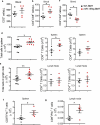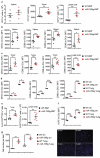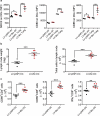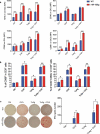Overexpression of microRNA-155 enhances the efficacy of dendritic cell vaccine against breast cancer
- PMID: 32117588
- PMCID: PMC7028336
- DOI: 10.1080/2162402X.2020.1724761
Overexpression of microRNA-155 enhances the efficacy of dendritic cell vaccine against breast cancer
Abstract
MicroRNA 155 (miR-155) plays important roles in the regulation of the development and functions of a variety of immune cells. We previously revealed a vital role of miR-155 in regulating the function of dendritic cells (DCs) in breast cancer. miR-155 deficiency in DCs impaired their maturation, migration, cytokine production, and ability to activate T cells. In the current study, to exploit the therapeutic value of miR-155 for breast cancer, we examined the impact of overexpression of miR-155 on antitumor responses generated by DC vaccines. We boosted miR-155 expression in DCs by generating a miR-155 transgenic mouse strain (miR-155tg) or using lentivirus transduction. DCs overexpressing miR-155 exhibited enhanced functions in response to tumor antigens. Using miR-155 overexpressing DCs, we generated a DC vaccine and found that the vaccine resulted in enhanced antitumor immunity against established breast cancers in mice, demonstrated by increased effector T cells in the mice, suppressed tumor growth, and drastically reduced lung metastasis. Our current study suggests that in future DC vaccine development for breast cancer or other solid tumors, introducing forced miR155 overexpression in DCs via various approaches such as viral transduction or nanoparticle delivery, as well as including other adjuvant agents such as TLR ligands or immune stimulating cytokines, may unleash the full therapeutic potential of the DC vaccines.
Keywords: Microrna-155; breast cancer; dendritic cell; immune therapy; vaccine.
© 2020 The Author(s). Published with license by Taylor & Francis Group, LLC.
Figures







Similar articles
-
miRNA-5119 regulates immune checkpoints in dendritic cells to enhance breast cancer immunotherapy.Cancer Immunol Immunother. 2020 Jun;69(6):951-967. doi: 10.1007/s00262-020-02507-w. Epub 2020 Feb 20. Cancer Immunol Immunother. 2020. PMID: 32076794 Free PMC article.
-
microRNA-155 deficiency impairs dendritic cell function in breast cancer.Oncoimmunology. 2016 Sep 9;5(11):e1232223. doi: 10.1080/2162402X.2016.1232223. eCollection 2016. Oncoimmunology. 2016. PMID: 27999745 Free PMC article.
-
miR-155 Upregulation in Dendritic Cells Is Sufficient To Break Tolerance In Vivo by Negatively Regulating SHIP1.J Immunol. 2015 Nov 15;195(10):4632-40. doi: 10.4049/jimmunol.1302941. Epub 2015 Oct 7. J Immunol. 2015. PMID: 26447227
-
Dendritic cell gene therapy.Surg Oncol Clin N Am. 2002 Jul;11(3):645-60. doi: 10.1016/s1055-3207(02)00027-3. Surg Oncol Clin N Am. 2002. PMID: 12487060 Review.
-
Dendritic cell-based combined immunotherapy with autologous tumor-pulsed dendritic cell vaccine and activated T cells for cancer patients: rationale, current progress, and perspectives.Hum Cell. 2003 Dec;16(4):175-82. doi: 10.1111/j.1749-0774.2003.tb00151.x. Hum Cell. 2003. PMID: 15147037 Review.
Cited by
-
The Role of the Tumor Microenvironment in Developing Successful Therapeutic and Secondary Prophylactic Breast Cancer Vaccines.Vaccines (Basel). 2020 Sep 14;8(3):529. doi: 10.3390/vaccines8030529. Vaccines (Basel). 2020. PMID: 32937885 Free PMC article. Review.
-
Role of miR-155 in inflammatory autoimmune diseases: a comprehensive review.Inflamm Res. 2022 Dec;71(12):1501-1517. doi: 10.1007/s00011-022-01643-6. Epub 2022 Oct 29. Inflamm Res. 2022. PMID: 36308539
-
MicroRNA155 Plays a Critical Role in the Pathogenesis of Cutaneous Leishmania major Infection by Promoting a Th2 Response and Attenuating Dendritic Cell Activity.Am J Pathol. 2021 May;191(5):809-816. doi: 10.1016/j.ajpath.2021.01.012. Epub 2021 Feb 2. Am J Pathol. 2021. PMID: 33539779 Free PMC article.
-
Epigenetic modulations of immune cells: from normal development to tumor progression.Int J Biol Sci. 2023 Oct 2;19(16):5120-5144. doi: 10.7150/ijbs.88327. eCollection 2023. Int J Biol Sci. 2023. PMID: 37928272 Free PMC article. Review.
-
Role and Significance of MicroRNAs in the Relationship Between Obesity and Cancer.Balkan Med J. 2025 May 5;42(3):188-200. doi: 10.4274/balkanmedj.galenos.2025.2025-3-60. Balkan Med J. 2025. PMID: 40326803 Free PMC article. Review.
References
-
- Lim DS, Kim JH, Lee DS, Yoon CH, Bae YS.. DC immunotherapy is highly effective for the inhibition of tumor metastasis or recurrence, although it is not efficient for the eradication of established solid tumors. Cancer Immunol Immunother. 2007;56(11):1817–14. doi:10.1007/s00262-007-0325-0. - DOI - PMC - PubMed
Publication types
MeSH terms
Substances
Grants and funding
LinkOut - more resources
Full Text Sources
Medical
